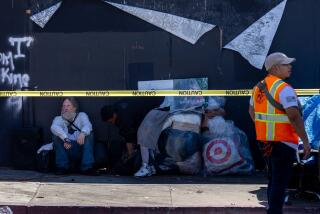Imagine if L.A. put the same effort into housing the homeless that it does Olympic athletes

- Share via
In the summer of 2028, hundreds of thousands of athletes, support staff and tourists will flood into Los Angeles for the 34th Olympiad, all needing a roof over their heads immediately. Within hours, they will all find one.
Meanwhile, nearly 60,000 men, women and children continue to languish on L.A. sidewalks, underpasses, in cars and crowded shelters, their numbers growing every year — and our leaders say it will take years to find them shelter.
So here’s an idea: What if we treated homeless Angelenos with the same urgency and humanity that we will treat the visiting rowers and gymnasts? What if we eradicated homelessness not in eight years, or three years, but in a matter of months?
Believe it or not, there’s a plan for that.
When James Murez first mentioned the idea to me, we were chatting at the Venice farmers market, which he created and manages.
Murez is a tall, shaggy-haired man pushing 60 with a long history of improbable ideas that, in the end, come to fruition. One of those ideas was for a computer you can carry — he holds an early patent on the laptop.
Murez has now turned his attention to homeless people, whose tents and encampments he sees as a clear sign of the city’s political and moral failing. Instead of slowly creating expensive temporary housing for them over a period of years, he has what he thinks is a far better idea: rapidly creating a housing and service center for every single homeless person.
Murez has an ideal location in mind: hundreds of acres of city-controlled land abutting Los Angeles International Airport.
In the 1970s and ‘80s, Federal Aviation Administration grants enabled Los Angeles World Airports to acquire some 350 acres of LAX-adjacent land along both sides of Westchester Parkway. Most of it came with restrictions against residential use. A small part of the land, about 27 acres, is unrestricted.
In June 2016, the City Council adopted a development plan for the area known as the LAX Northside Plan Update. The largest development, some 70 acres, would include 800,000 square feet of offices, retail, hotels and open space.
Five acres of the land is currently set aside to quarantine horses flown in from overseas. It seems like a low bar to expect city officials to find space for desperate humans before horses.
The LAX Northside Plan is years from being shovel-ready. Getting homeless people off our streets and into shelters is urgent. And we could do it now.
Murez proposes using the land for temporary homeless shelters and services. He estimates that of the 350 acres, between 70 and 175 acres could support temporary emergency housing, provided the government waives residential restrictions on them.
The actual shelters would consist of reinforced tent structures of the kind cities use when, say, Olympic athletes come to town. They are quick to set up and take down, highly configurable, and — surprise — already in use as emergency homeless housing in many places.
The Samoshel shelter on just off the 10 Freeway at Lincoln Boulevard in Santa Monica, for example, provides 70 homeless men and women with separate living quarters and a broad range of health services. The Leeward Coast Homeless Shelter, a tent shelter opened in 2007 in Waianae, Hawaii, was built in five months. Tent structures in San Diego went up in a matter of weeks, taking 700 souls off the sidewalks.
Murez envisions an array of such shelters on the land near LAX, laid out in a thoughtful, environmentally sound way. Families would be in one area, those needing addiction or mental health services in another. Garden areas for food production could serve both health and therapeutic needs. Some tents would serve as social service centers, security stations, dining and hygiene areas. LAX and the Inglewood stadium complex, two of the largest employers of entry-level labor in the region, would be minutes away.
How many homeless men, women and children could this project serve? The Leeward Coast Homeless Shelter serves up to 300 homeless on 29,000 square feet. On 175 acres, that could mean thousands of people housed.
The impact of a large transitional housing village would resonate across the city. At present, the law prohibits removing homeless encampments because the city doesn’t have enough beds or services for the people living in them. Under Murez’s plan, every person currently sleeping in an alley, under a freeway or in a park, would have a safe bed, the services he or she needs, warm showers and hot meals. Residents and businesses would get sidewalks and parks back, while the city could work on longer-term housing solutions. It’s true some people will always prefer sleeping outdoors, but the city can’t even begin to address their resistance until it has enough indoor facilities for all.
Mayor Eric Garcetti has said that in the best-case scenario it will take the city a decade to provide housing for every person who needs it. Current projects for transitional shelters are bogged down with neighborhood objections, and even then don’t begin to reach the scale needed to get every homeless person off the streets. Meanwhile, the number of homeless people grows year over year. The Murez plan would take less than a year to place every single homeless man, woman and child under a safe, clean roof.
“They could just start using the land instantly,” Murez said.
Come 2028, city leaders will rise to an Olympian challenge. Why not now?
Rob Eshman is the former publisher and editor-in-chief of the Jewish Journal. He blogs at foodaism.com.
More to Read
A cure for the common opinion
Get thought-provoking perspectives with our weekly newsletter.
You may occasionally receive promotional content from the Los Angeles Times.









